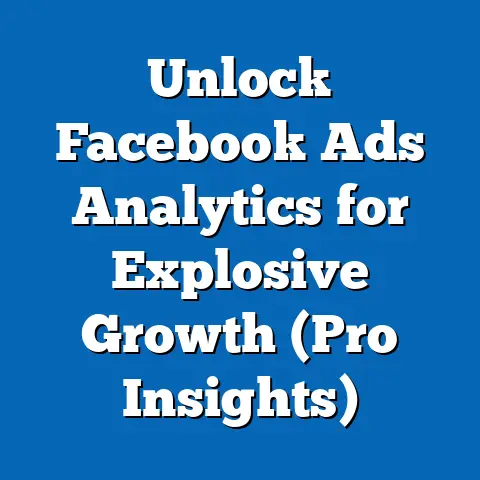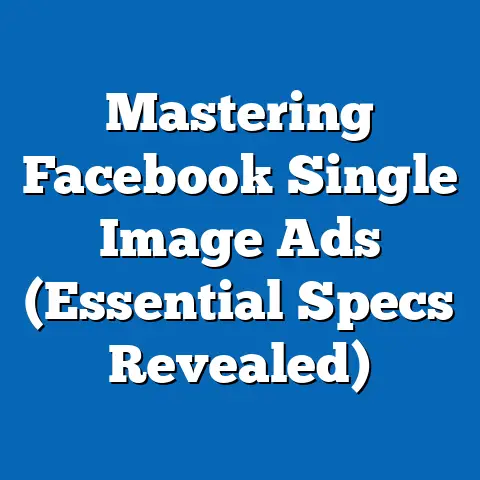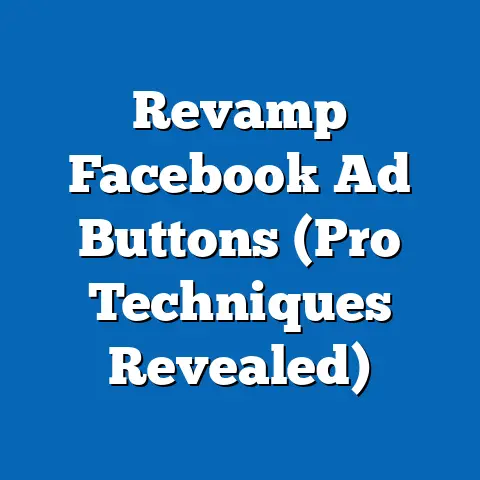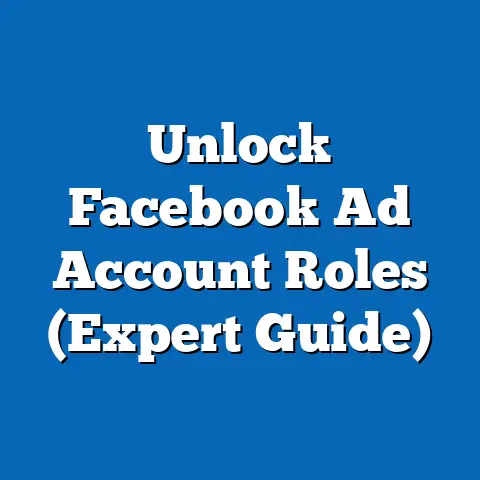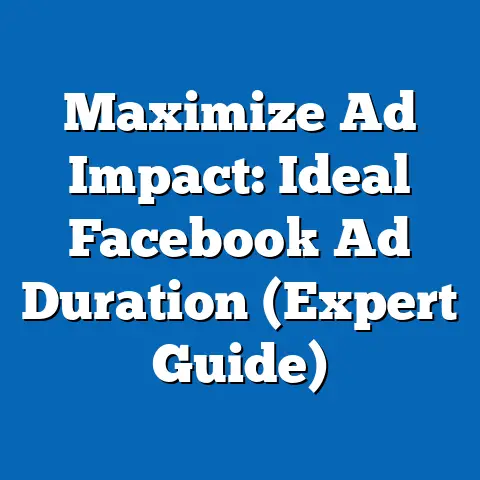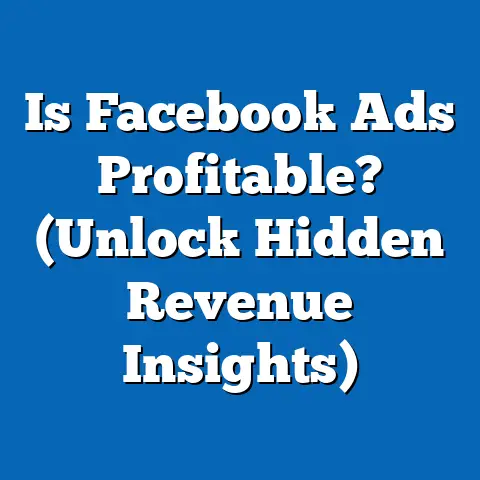Perfect Facebook Image Ads (Essential Text Tips)
“What if I told you that nearly 90% of Facebook image ads fail to capture attention simply because of poorly crafted text?” I know, it sounds like a bold claim, but after years of managing Facebook ad campaigns for various businesses, I’ve seen firsthand how crucial the right words are. We often get caught up in the visuals – the perfect image, the eye-catching video – but forget that text is the voice of your ad. It’s what speaks to your audience, tells them why they should care, and ultimately, drives them to take action.
Think about it. You’re scrolling through your Facebook feed, bombarded with images and videos. What makes you stop? It’s often a combination of a compelling visual and a headline or a snippet of text that instantly grabs your attention. The text is your opportunity to connect with your audience on a personal level, to address their needs, and to offer a solution.
But here’s the thing: crafting effective text for Facebook image ads is an art and a science. It’s not just about writing catchy phrases; it’s about understanding your audience, speaking their language, and using persuasive techniques to guide them towards conversion.
I’ve seen mediocre ads transformed into high-converting powerhouses simply by tweaking the text. A simple change in the headline, a more compelling call-to-action, or even just a few carefully chosen words in the ad copy can make all the difference. According to a recent study by Neilson, ads with clear and concise messaging are 27% more effective than those with ambiguous or confusing language.
Section 1: Understanding Facebook Image Ads
Let’s start with the basics. What exactly are Facebook image ads, and why are they such a powerful tool for digital marketing?
Simply put, Facebook image ads are advertisements that use a single image to convey a message and drive traffic to a website, landing page, or app. They appear in users’ Facebook feeds, on the right-hand column of the desktop site, and within Facebook Marketplace. Image ads are incredibly versatile and can be used for a wide range of purposes, from promoting products and services to generating leads and building brand awareness.
I remember when I first started running Facebook ads, I underestimated the power of a well-crafted image ad. I thought it was all about the visual. I quickly learned that a great image is only half the battle. You need compelling text to tell the story, to create a connection, and to drive action.
The Anatomy of a Facebook Image Ad
To create effective image ads, it’s essential to understand the key components:
For example, if you’re promoting a new fitness program, your image might show someone achieving their fitness goals, while your text highlights the benefits of the program and includes a call-to-action to “Join Now.”
I’ve found that when the image and text are perfectly aligned, the ad becomes much more effective at capturing attention and driving conversions.
Facebook’s Ad Policies and the 20% Text Rule
It’s crucial to be aware of Facebook’s ad policies regarding text in images. For a long time, Facebook had a strict “20% text rule,” which limited the amount of text that could be included in an image. This rule was designed to improve the user experience and prevent overly cluttered ads.
While Facebook has officially removed the 20% text rule, they still emphasize the importance of avoiding excessive text in images. Ads with less text tend to perform better and reach a wider audience.
I always advise my clients to keep the text in their images to a minimum and focus on creating visually appealing ads with clear and concise messaging. Facebook provides a text overlay tool that can help you assess whether your image contains too much text.
Key Takeaway: Facebook image ads are a powerful tool for digital marketing, but it’s essential to understand the anatomy of an ad, align the text and image, and adhere to Facebook’s ad policies.
Next Step: Review your existing Facebook image ads and assess whether the text and image are aligned and whether you’re adhering to Facebook’s guidelines.
Section 2: The Psychology Behind Text in Ads
Now, let’s delve into the fascinating world of psychology and explore how text can influence potential customers. Understanding the psychological triggers that motivate people to take action is crucial for crafting effective ad copy.
Psychological Triggers in Ad Text
-
Scarcity: The principle of scarcity suggests that people are more likely to want something if they believe it’s in limited supply or available for a limited time. Incorporating phrases like “Limited Time Offer,” “While Supplies Last,” or “Only a Few Spots Left” can create a sense of urgency and encourage people to take action.
I remember running a campaign for a local restaurant offering a special discount for a limited time. By using the phrase “Limited Time Offer” in the ad copy, we saw a significant increase in click-through rates and reservations. * Urgency: Similar to scarcity, urgency emphasizes the importance of acting quickly. Phrases like “Act Now,” “Don’t Miss Out,” or “Offer Ends Soon” can create a sense of urgency and motivate people to take action. * Social Proof: People are more likely to trust and be influenced by the actions and opinions of others. Incorporating social proof into your ad text, such as testimonials, reviews, or the number of customers who have already purchased your product, can build trust and credibility.
I ran an ad campaign for an online course that included a testimonial from a satisfied student. The testimonial highlighted the benefits of the course and the positive impact it had on the student’s career. This social proof helped to increase enrollment in the course. * Authority: People tend to trust and respect experts and authority figures. If you have endorsements from industry leaders or certifications that demonstrate your expertise, be sure to highlight them in your ad text. * Reciprocity: The principle of reciprocity suggests that people are more likely to do something for you if you’ve done something for them. Offering a free gift, discount, or valuable piece of content in exchange for their email address or other information can encourage them to take action.
I’ve run numerous lead generation campaigns where we offered a free e-book or a free consultation in exchange for the user’s email address. This reciprocity-based approach proved to be highly effective in generating qualified leads.
Scarcity: The principle of scarcity suggests that people are more likely to want something if they believe it’s in limited supply or available for a limited time. Incorporating phrases like “Limited Time Offer,” “While Supplies Last,” or “Only a Few Spots Left” can create a sense of urgency and encourage people to take action.
I remember running a campaign for a local restaurant offering a special discount for a limited time. By using the phrase “Limited Time Offer” in the ad copy, we saw a significant increase in click-through rates and reservations. * Urgency: Similar to scarcity, urgency emphasizes the importance of acting quickly. Phrases like “Act Now,” “Don’t Miss Out,” or “Offer Ends Soon” can create a sense of urgency and motivate people to take action. * Social Proof: People are more likely to trust and be influenced by the actions and opinions of others. Incorporating social proof into your ad text, such as testimonials, reviews, or the number of customers who have already purchased your product, can build trust and credibility.
I ran an ad campaign for an online course that included a testimonial from a satisfied student. The testimonial highlighted the benefits of the course and the positive impact it had on the student’s career. This social proof helped to increase enrollment in the course. * Authority: People tend to trust and respect experts and authority figures. If you have endorsements from industry leaders or certifications that demonstrate your expertise, be sure to highlight them in your ad text. * Reciprocity: The principle of reciprocity suggests that people are more likely to do something for you if you’ve done something for them. Offering a free gift, discount, or valuable piece of content in exchange for their email address or other information can encourage them to take action.
I’ve run numerous lead generation campaigns where we offered a free e-book or a free consultation in exchange for the user’s email address. This reciprocity-based approach proved to be highly effective in generating qualified leads.
Persuasive Language and Emotional Appeal
In addition to psychological triggers, using persuasive language and appealing to emotions can also be highly effective in ad text.
- Focus on Benefits, Not Features: Instead of simply listing the features of your product or service, focus on the benefits that it provides to the customer. How will it make their life easier, better, or more enjoyable?
- Use Strong Verbs and Adjectives: Choose verbs and adjectives that evoke emotion and create a sense of excitement and anticipation.
- Tell a Story: People are naturally drawn to stories. Use your ad text to tell a compelling story that resonates with your target audience.
- Address Pain Points: Identify the pain points of your target audience and address them directly in your ad text. Show them that you understand their challenges and offer a solution.
Examples of Successful Ads Using Psychological Principles
Let’s look at some examples of successful ads that effectively utilize psychological principles:
- “Limited Time Offer: Get 50% Off Your First Month!” (Scarcity and Urgency)
- “Join Over 10,000 Satisfied Customers!” (Social Proof)
- “As Seen on [Industry Leading Publication]!” (Authority)
- “Download Our Free E-book and Learn the Secrets to Success!” (Reciprocity)
- “Finally, a Solution to Your [Pain Point]!” (Addressing Pain Points)
I’ve seen these principles work time and time again. By understanding the psychology behind consumer behavior, you can craft ad text that resonates with your target audience and drives conversions.
Key Takeaway: Understanding the psychological triggers that motivate people to take action is crucial for crafting effective ad copy. Incorporate principles like scarcity, urgency, social proof, and reciprocity into your ad text, and use persuasive language to appeal to emotions.
Next Step: Analyze your existing Facebook ads and identify opportunities to incorporate psychological principles and persuasive language.
Section 3: Crafting the Perfect Headline
The headline is arguably the most important part of your Facebook image ad. It’s the first thing people see, and it’s what determines whether they’ll stop scrolling and pay attention to your ad. A compelling headline can make all the difference between a successful ad and one that gets ignored.
I’ve spent countless hours testing different headlines for my Facebook ads, and I’ve learned that there’s no one-size-fits-all formula. However, there are some proven techniques that can help you write headlines that grab attention and drive clicks.
Techniques for Writing Compelling Headlines
- Use Numbers: Numbers are naturally eye-catching and can make your headline more specific and credible. For example, “5 Proven Strategies to Boost Your Facebook Ad ROI” is more compelling than “Strategies to Boost Your Facebook Ad ROI.”
- Ask Questions: Questions can pique curiosity and encourage people to click on your ad to find the answer. For example, “Are You Making These Common Facebook Ad Mistakes?”
- Address Pain Points: Identify the pain points of your target audience and address them directly in your headline. For example, “Tired of Wasting Money on Facebook Ads?”
- Use Power Words: Power words are words that evoke emotion and create a sense of excitement and urgency. Examples include “Amazing,” “Secret,” “Proven,” “Instant,” and “Guaranteed.”
- Highlight Benefits: Focus on the benefits that your product or service provides to the customer. For example, “Get More Leads and Sales with Our Facebook Ad Services.”
- Create a Sense of Mystery: Tease the reader with a hint of information that makes them want to learn more. For example, “The One Thing You’re Missing in Your Facebook Ads.”
Examples of High-Performing Headlines
Here are some examples of high-performing headlines from various niches:
- E-commerce: “Shop Our New Collection of Summer Dresses – Limited Time Offer!”
- Software: “The #1 Tool to Automate Your Social Media Marketing”
- Education: “Learn a New Skill in Just 30 Days – Guaranteed!”
- Health & Fitness: “Lose Weight and Get in Shape with Our Proven Program”
- Finance: “The Secret to Building Wealth in Your 20s”
I’ve seen these types of headlines work incredibly well across different industries. The key is to tailor them to your specific target audience and value proposition.
A/B Testing Your Headlines
The best way to determine which headlines are most effective is to A/B test them. A/B testing involves creating two or more versions of your ad with different headlines and running them simultaneously to see which one performs better.
Facebook Ads Manager provides built-in A/B testing tools that make it easy to test different headlines. You can track metrics like click-through rate, conversion rate, and cost per conversion to determine which headlines are most effective.
I recommend A/B testing your headlines regularly to continuously improve your ad performance. Even small changes in your headline can have a significant impact on your results.
Key Takeaway: The headline is the most important part of your Facebook image ad. Use numbers, ask questions, address pain points, use power words, and highlight benefits to write compelling headlines that grab attention and drive clicks.
Next Step: Brainstorm at least five different headlines for your next Facebook ad campaign and A/B test them to see which one performs best.
Section 4: Writing Engaging Ad Copy
While the headline grabs attention, the ad copy is what seals the deal. It’s your opportunity to provide more details about your product, service, or offer and persuade potential customers to take action. Writing engaging ad copy is an art, but it’s also a science. There are proven techniques that can help you craft ad copy that resonates with your target audience and drives conversions.
Tips for Concise and Impactful Ad Copy
- Keep it Short and Sweet: People have short attention spans, so it’s essential to keep your ad copy concise and to the point. Aim for no more than a few sentences.
- Focus on Benefits, Not Features: As mentioned earlier, focus on the benefits that your product or service provides to the customer. How will it make their life easier, better, or more enjoyable?
- Use Clear and Simple Language: Avoid jargon and technical terms that your target audience may not understand. Use clear and simple language that everyone can easily grasp.
- Speak Directly to Your Target Audience: Use language that resonates with your target audience and addresses their specific needs and pain points.
- Create a Sense of Urgency: As discussed earlier, creating a sense of urgency can motivate people to take action. Use phrases like “Limited Time Offer” or “Act Now” to encourage immediate response.
- Include a Strong Call-to-Action: Your ad copy should always end with a clear and compelling call-to-action that tells people exactly what you want them to do.
Frameworks for Effective Ad Copy: AIDA
One of the most popular frameworks for writing effective ad copy is AIDA, which stands for:
- Attention: Grab the reader’s attention with a compelling opening line. This could be a question, a surprising statistic, or a bold statement.
- Interest: Generate interest by highlighting the benefits of your product or service and addressing the reader’s needs and pain points.
- Desire: Create desire by showcasing the positive outcomes that the reader can achieve by using your product or service.
- Action: End with a clear and compelling call-to-action that tells the reader what you want them to do next.
I’ve used the AIDA framework countless times, and it’s consistently proven to be effective in driving conversions.
Here’s an example of how to apply the AIDA framework to a Facebook ad for a weight loss program:
- Attention: “Tired of struggling to lose weight?”
- Interest: “Our proven weight loss program has helped thousands of people achieve their fitness goals.”
- Desire: “Imagine feeling confident, healthy, and energized – without restrictive diets or grueling workouts.”
- Action: “Join Our Program Today and Start Your Transformation!”
Examples of Ad Copy That Leads to Conversion
Here are some additional examples of ad copy that effectively leads the audience down the conversion funnel:
- E-commerce: “Get Free Shipping on Orders Over $50! Shop Our New Arrivals Now.”
- Software: “Try Our Free 14-Day Trial and See How Our Software Can Streamline Your Workflow.”
- Education: “Enroll in Our Online Course and Learn the Skills You Need to Advance Your Career.”
- Health & Fitness: “Get Your Free Consultation and Discover the Best Weight Loss Plan for You.”
- Finance: “Download Our Free Guide to Investing and Start Building Your Wealth Today.”
I’ve found that the best ad copy is clear, concise, and focused on the benefits that the customer will receive. It also includes a strong call-to-action that tells people exactly what you want them to do.
Key Takeaway: Write concise and impactful ad copy that complements the visual elements of your Facebook image ads. Use the AIDA framework to guide your writing and focus on the benefits that your product or service provides to the customer.
Next Step: Review your existing Facebook ad copy and identify opportunities to make it more engaging and persuasive.
Section 5: Call-to-Action (CTA) Mastery
The call-to-action (CTA) is the final, and perhaps most critical, element of your Facebook image ad. It’s the button or link that encourages users to take a specific action, such as “Shop Now,” “Learn More,” or “Sign Up.” A compelling CTA can make all the difference between a successful ad and one that gets ignored.
I’ve seen ads with great images and compelling text fail to convert simply because they had a weak or unclear CTA. It’s essential to tell people exactly what you want them to do and make it easy for them to take that action.
Different Types of CTAs and When to Use Them
Facebook offers a variety of CTA buttons that you can use in your ads. Here are some of the most common ones and when to use them:
- Shop Now: Use this CTA when you want to drive sales of a specific product or service.
- Learn More: Use this CTA when you want to provide more information about your product, service, or offer.
- Sign Up: Use this CTA when you want to collect email addresses or encourage people to create an account.
- Download: Use this CTA when you want people to download a free e-book, guide, or software.
- Book Now: Use this CTA when you want people to book an appointment or reservation.
- Contact Us: Use this CTA when you want people to contact you with questions or inquiries.
I always recommend choosing the CTA that is most relevant to the goal of your ad campaign. If you’re trying to drive sales, use “Shop Now.” If you’re trying to generate leads, use “Sign Up” or “Download.”
Tips for Crafting Compelling CTAs
- Use Action Words: Start your CTA with a strong action word, such as “Shop,” “Learn,” “Sign,” “Download,” or “Book.”
- Create a Sense of Urgency: Add a sense of urgency to your CTA by using phrases like “Now,” “Today,” or “Limited Time.”
- Highlight the Benefits: Emphasize the benefits that the user will receive by taking action.
- Make it Stand Out: Use a contrasting color for your CTA button to make it stand out from the rest of your ad.
- Keep it Concise: Keep your CTA short and to the point. Aim for no more than a few words.
Examples of Effective CTAs
Here are some examples of effective CTAs in successful Facebook image ads:
- “Shop Now and Get 20% Off!”
- “Learn More About Our Proven Weight Loss Program”
- “Sign Up Today for a Free Trial”
- “Download Our Free E-book Now”
- “Book Your Appointment Online”
- “Contact Us for a Free Consultation”
I’ve seen these types of CTAs consistently drive high click-through rates and conversions. The key is to make them clear, compelling, and relevant to your target audience.
Key Takeaway: The call-to-action is the final, and perhaps most critical, element of your Facebook image ad. Choose the CTA that is most relevant to the goal of your ad campaign and craft it using action words, a sense of urgency, and a highlight of the benefits.
Next Step: Review your existing Facebook ads and assess whether your CTAs are clear, compelling, and relevant to your target audience.
Section 6: Testing and Optimizing Your Ads
Creating perfect Facebook image ads is an ongoing process. It’s not enough to simply create an ad and launch it. You need to continuously test and optimize your ads to improve their performance and maximize your ROI.
I’ve spent countless hours testing different elements of my Facebook ads, and I’ve learned that even small changes can have a significant impact on your results.
The Importance of Testing
Testing allows you to identify what works and what doesn’t work in your ads. By testing different headlines, ad copy, images, and CTAs, you can gradually refine your ads and improve their performance.
I recommend testing one element at a time to isolate the impact of each change. For example, if you want to test different headlines, keep everything else in your ad the same and only change the headline.
A/B Testing Methods and Tools
A/B testing involves creating two or more versions of your ad with different elements and running them simultaneously to see which one performs better.
Facebook Ads Manager provides built-in A/B testing tools that make it easy to test different elements of your ads. You can test headlines, ad copy, images, CTAs, targeting options, and more.
There are also third-party tools that can help you with A/B testing, such as AdEspresso and Revealbot. These tools offer more advanced features and analytics than Facebook Ads Manager.
Analyzing Ad Performance Data
To effectively optimize your ads, you need to analyze ad performance data. Facebook Ads Manager provides a wealth of data that can help you understand how your ads are performing.
Some of the key metrics to track include:
- Reach: The number of people who saw your ad.
- Impressions: The number of times your ad was displayed.
- Click-Through Rate (CTR): The percentage of people who clicked on your ad after seeing it.
- Conversion Rate: The percentage of people who took the desired action after clicking on your ad (e.g., making a purchase, signing up for a free trial).
- Cost Per Click (CPC): The amount you paid for each click on your ad.
- Cost Per Conversion (CPC): The amount you paid for each conversion.
By analyzing these metrics, you can identify areas where your ads are performing well and areas where they need improvement.
Case Studies of Text Optimization
Let’s look at some case studies of brands that improved their ad performance through text optimization:
- Company A: A local e-commerce store improved their click-through rate by 30% by testing different headlines that highlighted the benefits of their products.
- Company B: A software company increased their conversion rate by 20% by testing different CTAs that created a sense of urgency.
- Company C: A health and fitness company reduced their cost per conversion by 15% by testing different ad copy that addressed the pain points of their target audience.
I’ve seen these types of results time and time again. By continuously testing and optimizing your text, you can significantly improve the performance of your Facebook image ads.
Key Takeaway: Testing and optimizing your Facebook image ads is an ongoing process. Continuously test different elements of your ads, analyze ad performance data, and refine your text to improve results.
Next Step: Set up A/B tests for your existing Facebook ads and track the results to identify opportunities for optimization.
I hope this guide has provided you with the knowledge and tools you need to transform your Facebook ads from forgettable to unforgettable. Remember to:
- Understand the anatomy of a Facebook image ad and align the text and image.
- Incorporate psychological principles and persuasive language into your ad text.
- Craft compelling headlines that grab attention and drive clicks.
- Write engaging ad copy that complements the visual elements of your ads.
- Master the power of the call-to-action and tell people exactly what you want them to do.
- Continuously test and optimize your ads to improve their performance.
I’m confident that if you apply these tips to your own ad campaigns, you’ll see a significant impact on your success. So, what are you waiting for? Take the first step towards enhancing your Facebook advertising strategy today!
Final Call-to-Action: Download my free checklist of essential Facebook ad text tips and start creating perfect image ads today!

